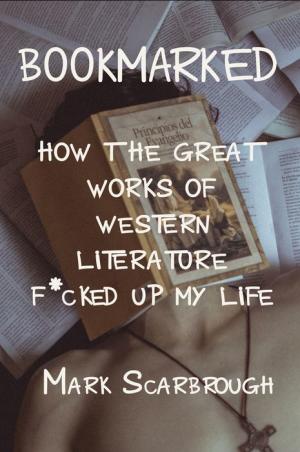New York Times bestselling cookbook author Mark Scarbrough lays bare on his complicated, near-obsessive relationship with books in his new memoir: Bookmarked: How The Great Works Of Western Literature F*cked Up My Life.
Intrigued? Check out the except below for a taste of what’s in store.
Excerpt from BOOKMARKED: HOW THE GREAT WORKS OF WESTERN LITERATURE F*CKED UP MY LIFE
Copyright 2021 by Mark Scarbrough. Propertius Press All rights reserved.
Caution: A Preface
Stop me if you’ve heard this one before: “I found myself in Middlemarch!” Or “Shakespeare saved my life!”
I call bullshit. Shakespeare never saved anyone. Least of all, me. Although I sure wanted him to. Ached for him to, somewhere in the marrow middle of my bones. And not only him but all the other literary lions, like William Blake, Charlotte Brontë, and Henry James, now dead and mounted on the wall of Western culture.
I got sucked in by their promises, the best things. A once upon a time that leads logically to the end. Characters who remain true to themselves, despite what the plot throws at them. And desires that can be—ta-da!—fulfilled. Or at least understood.
And something more tangible, too. Down in my soul’s basement, where the lights are dim and my hopes are laid away in boxes, I dreamed up a mad quest through the great books to find a home. To hear the crackle in a fireplace. To feel the weight of the covers at night. To breathe in and out all that’s human and loved.
Maybe I should have lowered my sights. Maybe only the main character gets home. Problem is, I’ve always felt like a minor one: the sidekick in a baggy sweater, the wiseacre two desks down. The guy who steps into a story, pushes it along in some vague way, and gets a one-liner as his reward: Years later, I heard he died in a car crash.
Or maybe I asked so much from the great books because of my upbringing. When I was ten, my parents left the Southern Baptist church. “It is too liberal,” they said, seemingly in unison, a plainsong truth-telling that led us to the upland pastures of American fundamentalism. Letters were sent. Ministers were challenged. Friends were lost.
Don’t get me wrong. I didn’t latch onto the great books because they were forbidden. I never once read under the sheets with a flashlight. Oh, sure, I had to skip the sex scenes and turn a blind eye to the notion that a liberal could be the good guy. Authors! What can you do?
But nothing could befoul us. We were the true believers. We interpreted the Vietnam War, Nixon, and everything else as a story, a plot, rushing toward the apocalypse. The world sinned, it burned up, and we got out alive. Time was a straight line.
Once I started reading, I discovered that novels, stories, plays, and even poems were alternate timelines, descending and ascending like a grid. They even got to the same places we believed in: just deserts or happily ever after. For a long time, I wanted to homestead on that scaffolding, even though it kept coming apart and slamming to the ground. I just wasn’t myself without a book in my hand.
Then I wasn’t myself with one. Over time, books stopped being words outside my skin and became shadowy bits inside my brain, alternate versions of me, telling their own stories. I morphed into a bizarre body of shredded volumes, stalking the far country of my imagination. That’s how I saw a long-dead poet manifest in front of me one night. How I got a job fishing monks out of gay bars. And ultimately why I tossed the person I loved over the cliff of insanity in a hail Mary! attempt to save my own brain from dissolving like a cheap paperback in a deluge.
All of which is to say, be careful what you read. It can fuck you up, too.
But don’t worry. There’s a truth beyond the great works of Western literature. Life may seem linear, forceps to tombstone. Instead, the cosmos is round and elastic, spiraled and helixed. Atoms, galaxies, your DNA—they spin and come back around. I got out from under literature’s curse. You can, too.
So this story is a comedy, like Dante’s, if not so divine. But there’s no good news without the bad, which is part and parcel of it. In books, in life, even in the old poet’s journey across the universe, the way up starts with the way down.
Want to read more? Then I have good news for you – I have a free copy of Bookmarked to give away to one lucky reader! Simply comment on this post by midnight (GMT) or Sunday 16th January to be in with a chance of winning.
Happy commenting!




